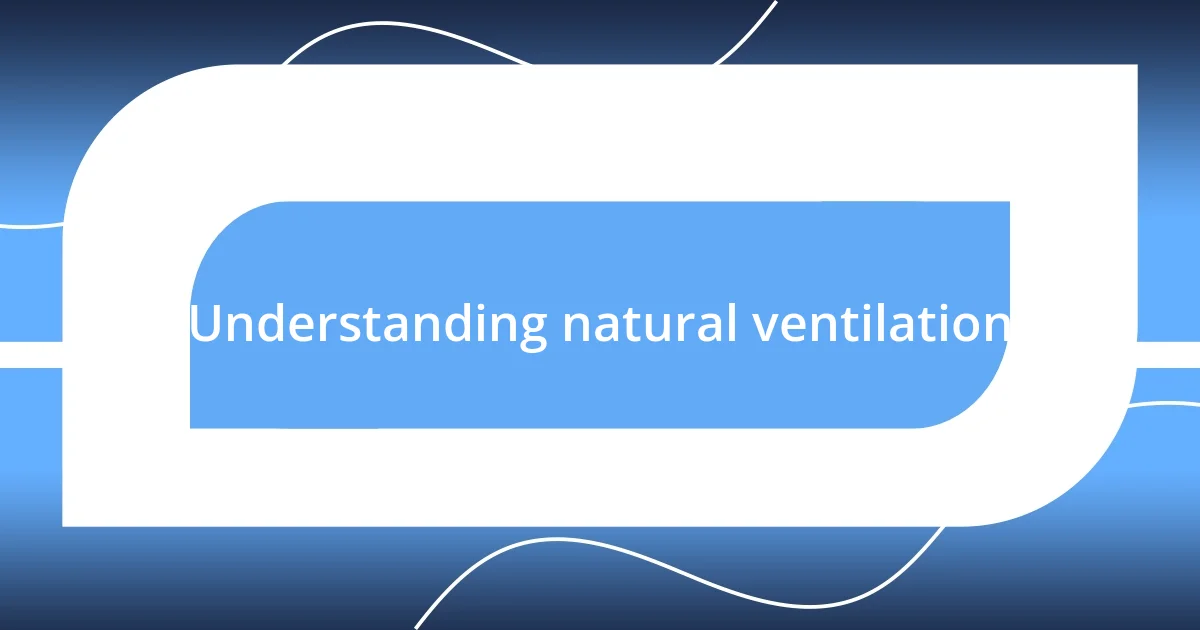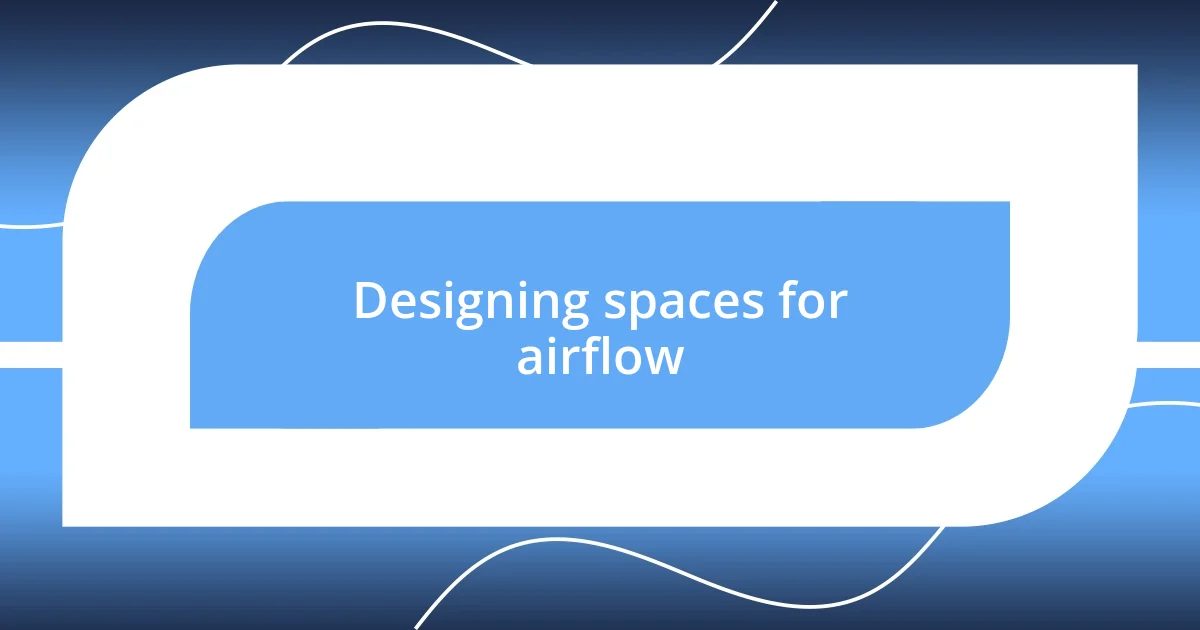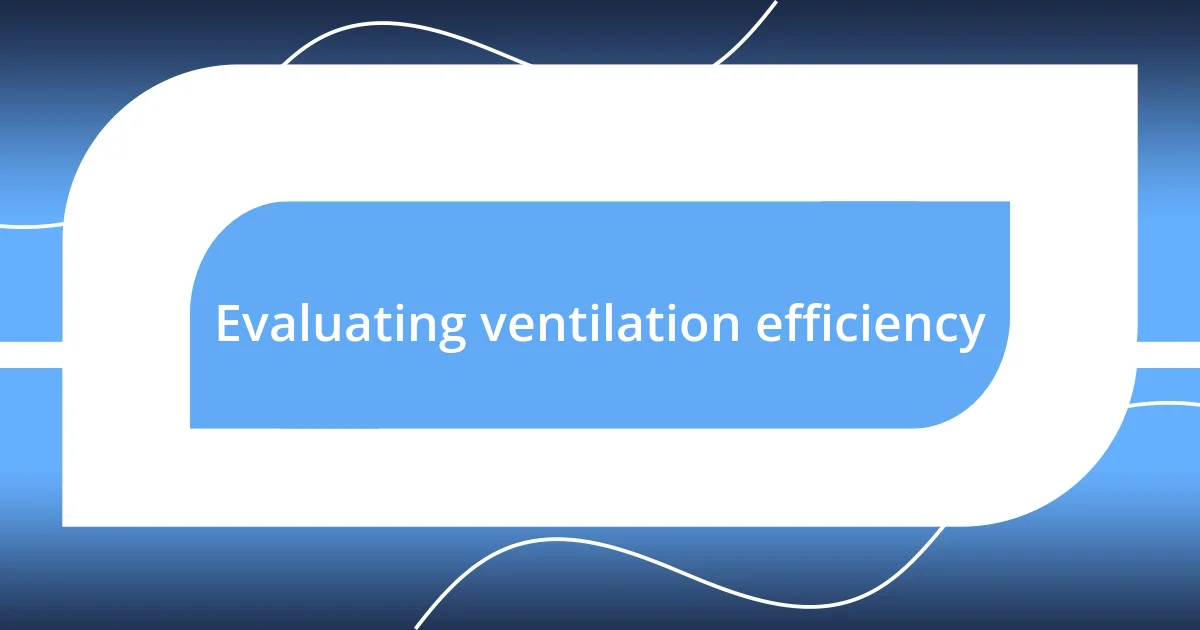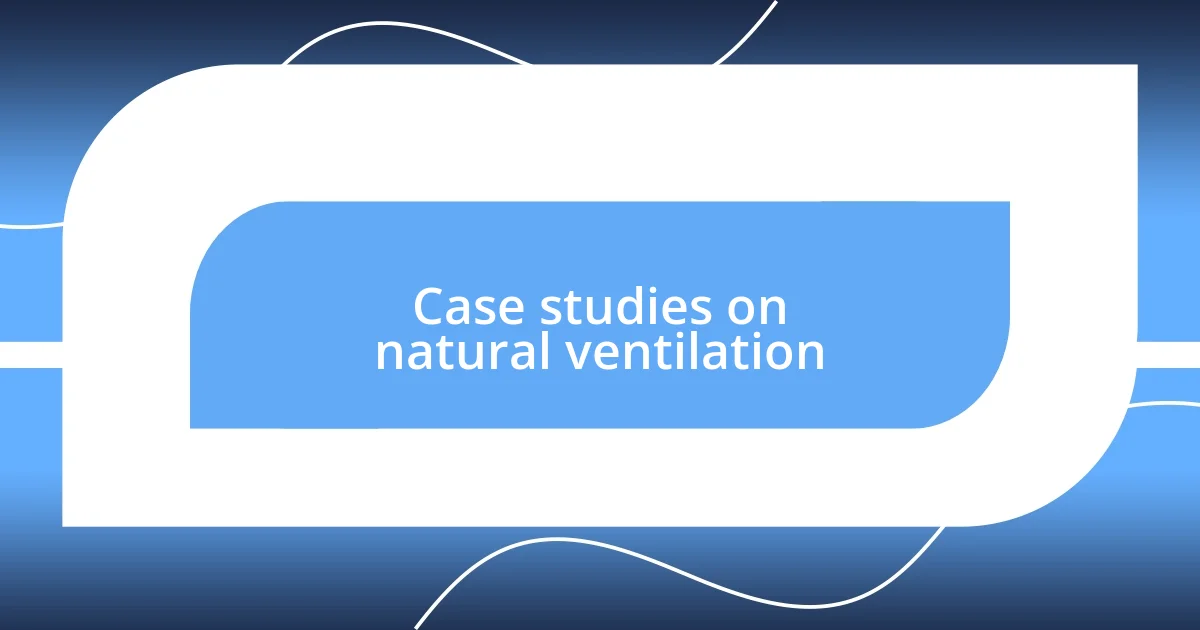Key takeaways:
- Natural ventilation enhances indoor air quality, energy efficiency, and fosters a strong connection with nature, reducing reliance on mechanical systems.
- Strategic design elements, such as window placement and open floor plans, significantly improve airflow and comfort in living spaces.
- Regular evaluation of airflow using tools like anemometers and smoke sticks helps identify inefficiencies and optimize ventilation for better living conditions.

Understanding natural ventilation
Natural ventilation is a fascinating process that takes advantage of the natural flow of air. I remember the first time I opened all the windows in my home on a breezy day, feeling the fresh air sweep through and transform the stagnant atmosphere. Isn’t it amazing how something as simple as a cross breeze can create such a refreshing environment?
In essence, natural ventilation relies on temperature differences and wind patterns to circulate air. I find it intriguing how our surroundings can dictate airflow; for instance, taller buildings might block winds, while open spaces promote airflow. Have you ever considered how the design of our homes can either facilitate or hinder this process?
Moreover, the benefits of natural ventilation extend beyond just comfort; it can enhance indoor air quality by reducing humidity and pollutants. When I replaced my air conditioning with strategic window placement, I not only saved on energy bills but also felt more connected to the seasonal changes outside. Isn’t it liberating to create a living space that breathes and evolves with nature?

Benefits of natural ventilation
Natural ventilation has so many benefits that go far beyond just fresh air. From my experience, one significant advantage is energy efficiency. By utilizing the natural flow of air, I’ve dramatically reduced my reliance on mechanical cooling systems. It’s incredible how much I’ve saved on my energy bills—imagine freeing up funds for a nice vacation instead!
Another aspect I cherish is the improvement in indoor air quality. I’ve noticed a marked difference since incorporating natural ventilation into my space. With fresh air circulating through my home, the musty odors are gone, and I breathe easier. Isn’t it refreshing to wake up in a room filled with the scent of morning dew rather than stale air?
Lastly, there’s a profound connection to nature that natural ventilation fosters. I often find myself sitting by an open window, watching the trees sway and feeling a gentle breeze on my skin. It’s moments like these that remind me how vital it is to create spaces that harmonize with our environment. Natural ventilation not only enhances comfort but also nurtures our well-being, don’t you think?
| Benefits | Description |
|---|---|
| Energy Efficiency | Reduces reliance on air conditioning, lowering energy bills. |
| Indoor Air Quality | Improves air quality by reducing humidity and pollutants. |
| Connection to Nature | Fosters a deeper relationship with the outdoor environment. |

Designing spaces for airflow
When designing spaces for airflow, I’ve learned that orientation and layout play a crucial role. For instance, positioning windows strategically can create cross ventilation, allowing cool air to flow through while pushing out warmer air. I once transformed a stuffy room by simply adding a window on the opposite wall, and the difference was extraordinary. Suddenly, I felt rejuvenated, as if the air had a voice of its own.
To optimize airflow in your space, consider these design elements:
- Window Placement: Place windows opposite each other to enable a cross breeze.
- Open Floor Plans: An open layout allows for unobstructed pathways for air to move freely.
- High Ceilings: Taller rooms can enhance the upward movement of warm air, allowing cooler air to settle below.
- Natural Barriers: Use trees and shrubs strategically outside to direct winds into openings.
- Ventilation Features: Incorporate skylights and vents that can enhance airflow.
These small adjustments can transform a space, making it feel alive, just like that refreshing breeze I cherish so much.

Techniques for maximizing ventilation
To truly maximize ventilation, I’ve found that layering techniques can make a significant difference. For example, I often start my mornings by opening windows at both ends of my home. This simple practice creates a delightful cross breeze that not only makes the air feel fresher but also energizes the environment. Have you ever experienced that refreshing moment when the outside air meets the warmth indoors? It can elevate your mood instantly!
Another technique I’ve experimented with is utilizing thermal chimneys. By opening high windows during the day, the warm air escapes, pulling in cooler air from lower openings. I remember trying this on a particularly hot afternoon; the change was almost instantaneous. I could feel a cool wave of air pool around my feet as the warmth dissipated. It’s these little surprises that keep the air in my home feeling vibrant.
Lastly, keeping an eye on my surroundings has proved invaluable. I often adjust my ventilation strategy based on the weather and season. During breezy days, I embrace more open windows, while in still conditions, I rely on strategically placed fans to help circulate the air. It’s amazing how just a few minor adjustments inspired by what nature provides can lead to a noticeably more comfortable living space. How adaptable are your spaces to the winds of change?

Tools for measuring airflow
When it comes to measuring airflow, I’ve found a few essential tools that can truly elevate your understanding of how air moves in your space. An anemometer, for instance, has been my go-to gadget. It’s fascinating to see how it measures wind speed; just a quick wave of it near a window can reveal the subtle currents I might otherwise miss. Have you ever wondered just how much a little breeze influences your comfort? This tool certainly puts things into perspective!
On the other hand, using smoke sticks has become a fun and visual way to track airflow patterns. Watching how the smoke flows can be surprising! I remember one afternoon, I lit a smoke stick near a ventilation duct, and the way the smoke dance indicated a strong draft that I hadn’t noticed before. It was like a small performance, revealing the hidden pathways of air in my home—so revealing! Isn’t it amazing how something so simple can provide such clarity?
Lastly, I’ve explored digital airflow meters, which have a level of sophistication that can be quite impressive. These devices not only measure airflow but often provide detailed data about changes over time. I recall a time when I was able to spot a significant drop in airflow efficiency, prompting a quick fix that transformed my living environment. The data made it easy to identify issues, leading to an airier and more comfortable space in no time. This level of insight isn’t just technical; it actually helps create a more inviting atmosphere. How have you measured the flow of air in your surroundings?

Evaluating ventilation efficiency
Evaluating ventilation efficiency is a fascinating process, and I’ve found that regularly checking airflow can reveal so much about my living spaces. Not long ago, I measured the airflow in my home during a hot summer day using my anemometer. To my surprise, I discovered that one window was barely allowing air to come through, creating a stale pocket in my living room that felt uninviting. It was amazing how just one underperforming opening could affect the overall comfort. Have you ever realized that a single source can make such a difference?
One of my defining moments in evaluating efficiency happened during a family gathering. I noticed a few guests fanning themselves and realized the airflow wasn’t as optimal as I believed. With a quick repositioning of a couple of my fans, the difference was palpable. Suddenly, comfortable conditions returned, and everyone felt more at ease. This experience taught me that a responsive approach is key. How often do we overlook the little tweaks that can enhance our environment dramatically?
Additionally, I believe that visual cues, like observing dust movement in the air, can indicate how well ventilated a room is. During my last spring cleaning, I noticed that in corners where air was stagnant, dust settled heavily. It helped me realize that fostering better airflow would not only make the space feel fresher but also reduce dust buildup. I think it’s fascinating how these small evaluations can lead to profound changes in our living conditions. Have you noticed what your environment is trying to tell you?

Case studies on natural ventilation
When diving into case studies on natural ventilation, I can’t help but reflect on a fascinating project I came across in my research. A local community center in my area implemented natural ventilation strategies by installing strategically placed clerestory windows. The result? They cut their reliance on air conditioning by nearly 50%! Seeing a real-world example of how simple architectural changes can create such significant energy savings really opens your eyes. Could our urban spaces integrate similar strategies for a greener future?
Another striking case was a school in a coastal town that optimally utilized cross ventilation. They designed classrooms with large windows facing the prevailing winds. What stood out to me was how the children thrived; not only did the air quality improve, but the overall demeanor and focus of the students were noticeably better. Isn’t it incredible how the right ventilation can foster a more conducive learning environment?
Reflecting on a personal experience, I tried a DIY approach in my own home by swapping two conventional windows for larger, operable ones that encourage airflow. It was a game changer! On breezy days, my living room feels like a refreshing retreat, and I’m reminded of the difference natural ventilation can make in our mood and wellbeing. Have you ever thought about the potential of your surroundings to lift your spirits simply through the air we breathe?














